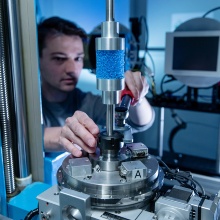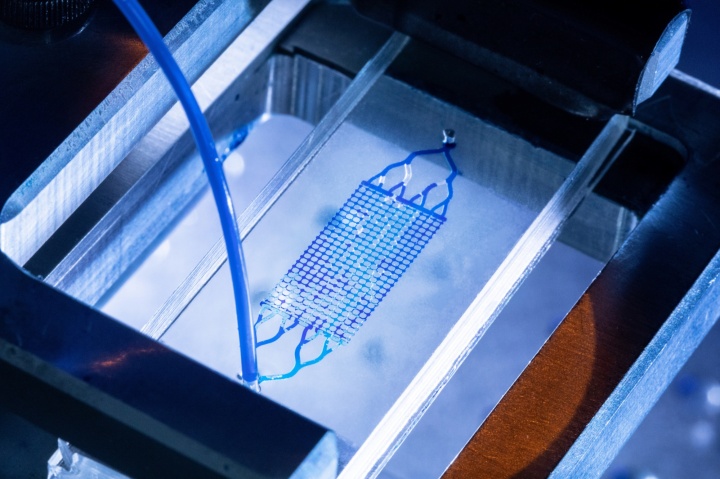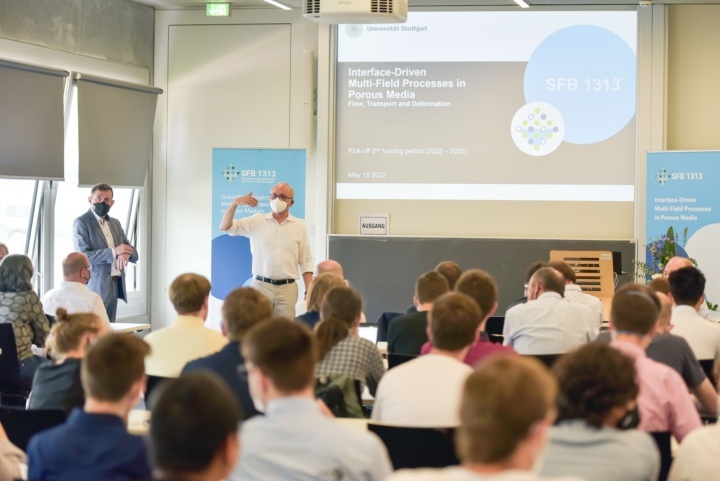Whether 3D images from the inside of a concrete block or the behavior of oil-water mixtures in the subsurface: X-ray tomographic and microfluidic methods are important pillars for visualizing and understanding the invisible flow and transport processes as well as the deformation behavior in porous media. The Porous Media Lab (PML) at the faculty, which has now found a pooled location on the Vaihingen campus, offers a comprehensive platform for this purpose. As a "shared lab", it is also available to national and international visiting scientists.
A core component of the PML is a self-developed X-ray tomograph, the XRCT Lab. It generates 3D images from non-transparent materials and enables researchers to gain high-resolution insights into phenomena at the pore scale. What makes it special is that the XRCT Lab combines imaging with physical experiments and can thus visualize how, for example, pressure, the flow of liquids or temperature fluctuations in a material affect effective material properties at the pore level.
The second centerpiece of the PML is the Microfluidic Lab, where synthetic porous materials can be created. For this purpose, opto-lithographic methods are used to create a kind of negative, which is then poured with a soft polymer (PDMS) in the next step. This creates a two-dimensional porous medium that is transparent and can be examined under a microscope. In this way, it is possible, for example, to visualize how multiphase fluids, such as an oil-water mixture, behave in a porous medium - findings that could find potential applications in deep geothermal energy or fuel cells, among other things.
In addition, the PML also includes a Specimen Preparation Lab, which provides equipment and methods for the preparation of rock specimens and the fabrication of polymer specimens (using various 3D printing techniques or laboratory-based injection molding). For observing the macroscopic material behavior of larger samples with diameters of a few centimeters, both the Granular Media Lab and the Rock Physics Lab have various low- and high-pressure cells for characterizing the stress-dependent material behavior of rock and soil samples. Finally, the Rheology Lab enables scientists to mechanically characterize soft materials such as (multi-)functional polymers for actuator applications, which are needed for example in "soft robotics".
Experimenting with Porous Media
Prof. Dr.-Ing. Holger Steeb, Forschungsleiter im SFB 1313 (poröse Medien) und im ExC SimTech sowie Direktor am Institut für Mechanik im Bauwesen der Fakultät, und sein Team geben einen Einblick in das Experimentieren mit porösen Medien.
Key for data-driven simulation models
Understanding complex physical processes, some of them time-dependent, at the pore scale is key to the development of further data-driven simulation models. The PML is also a central experimental platform, both for the Cluster of Excellence „Data-integrated Simulation Science“ (EXC 2075, SimTech), and for the Collaborative Research Center "Interfacially-driven multi-field processes in porous media. Flow, Transport and Deformation" (SFB 1313) at the University of Stuttgart. In SFB 1313, which started its second funding phase with a kick-off event in May 2022, around 60 researchers from nine institutes at the University of Stuttgart and around 35 partner institutions are working on the overarching goal of gaining a fundamental understanding of the processes occurring in porous media.
Fruitful for research collaborations
Researchers from other institutes at the University of Stuttgart as well as visiting scientists from Germany and abroad also use the PML for their research. "The PML, which is still very young, has already been able to establish itself very successfully as a "shared lab", and we are able to permanently expand the experimental characterization methods," says Prof. Holger Steeb, head of research in SFB 1313 and member of the board of directors in the Cluster of Excellence SimTech. "It is impressive how the PML fertilizes outstanding local, national and international research collaborations."
Expert Contact:
Prof. Dr.-Ing. Holger Steeb, University of Stuttgart, Institut of Applied Mechanics (MIB), Tel.: +49 711 685 66029, E-Mail
Homepage Porous Media Lab https://www.mib.uni-stuttgart.de/pml




